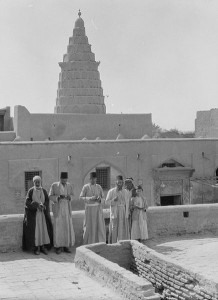Iraq and the Jewish People: An Ancient Relationship
Part I
The mass emigration of Jews from Iraq in the years 1950 and 1951 brought to an end the existence of a community which had been in the region for millennia. From the very birth of Judaism in what was then Mesopotamia, Jews have been present in or very strongly linked to the area. The emigration from Iraq in the early 1950s caused a tremendous cultural loss for the Jews. It is not within the scope of this paper to fully examine what has been lost; however, it is important to make mention of the great culture which developed over centuries. In discussions of this type, researchers tend to focus on historical fact and neglect those valuable aspects of culture that are now gone.
This paper examines the relationship and interactions between Jews and the region now known as Iraq throughout the ages. The discussion will focus on a number of different periods, most notably:
1. The age of Mesopotamia, the birthplace of Judaism,
2. Assyria and Babylonia and the conquest of Israel and Judea,
3. The rise of the Babylonian community in Talmudic times,
4. The Geonic era, and
5. The Modern era—Ottoman, British, and Iraqi periods.
The question under examination is that of the effect which Iraq (known also as Mesopotamia, Assyria, and Babylonia) had on the Jewish people. The study begins with the very origins of the Jewish nation, moves through major developments for the Jewish community and, at the end, makes reference to the relevance of the discussion for the present day, referring to the problems the Jewish people face today vis-à-vis Iraq and the Arab world.
The review begins with the father of Judaism, Abraham, and his life in Iraq, then known as Mesopotamia.
Mesopotamia: Birthplace of Judaism
Before discussing the life of Abraham, it is important to review the geography and history of the region. On a map of modern Iraq, the southern end, or the Persian Gulf area, was, in ancient times, Sumer. Sumer was, in many ways, the earliest civilization, and the location of Ur of the Chaldees, Abraham’s birthplace. In the center of modern Iraq, where the Tigris and Eu-phrates rivers meet, is the area once known as Babylonia—the city of Babylon and its environs. Further north, where the rivers diverge, is the area that was known in ancient times as Assyria.
This region is one of the key places in which civilization came to be. Stories in the Book of Genesis clearly place the origins of civilization in this region. For example, the Tower of Babel story is clearly designed to convey, and, in fact, actually states, that this is the region from which the human race spread and all of the languages developed. The Bible expresses what has been learned from hundreds of years of archaeological excavations and study of clay tab-lets—that the ancient civilization which began first in Sumer, the area closest to the Gulf, and then spread through the rest of Mesopotamia, was a very advanced one. This civilization was highly developed in terms of subjects such as mathematics and religion (although pagan). Politically, the area was quite advanced as well; to a great extent, the need for irrigation of the territory required government organization early on.
The region being so advanced makes the origins of Judaism in the location understandable. Non-literal interpretation of midrash—namely, the stories in which Abraham comes to recognize the falseness of paganism and the truth of monotheism before the God reveals Himself to him—makes the developments seem almost natural given the circumstances. Abraham, as we know, moved from Ur of the Chaldees—an area which has been excavated and whose where-abouts have been documented—to Haran, in Assyria, and finally to Israel. The heritage which would have come to Israel with Abraham and his family must have been, in some senses, negative, having come from so pagan a region. Biblical accounts include mention of names of members of Abraham’s family whom we know to be connected with the moon cult.
On the other hand, much of what Abraham brought with him must also have been traditional law. On the top of Hammurabi’s Code from 1800 BCE there is an image of the sun god, considered to be the god of justice, handing down the law to his assistants. The assistants were known in Akkadian as Kittu—which in Hebrew is “kenut,” uprightness—and Mesharu—in Hebrew, “mesharim,” honesty or uprightness. These are values which came with Abraham as well. Clearly the pagan religion to which Abraham had been exposed in Ur of the Chaldees was unlike others—for example, the Canaanite religion, which included human sacrifice. Rather, the problem with the pagan religion with which Abraham was familiar was simply in the fact that it was polytheistic and, as such, did not perceive gods as moral figures.
It is for this reason that it is understandable that the Book of Genesis’ account of the creation includes hints rejecting the pagan ideas prominent in the Mesopotamian creation story. For example, in ancient Mesopotamian creation, the god spits into dirt to make a human being; in Genesis, God breathes spirit into a human being. The polemic is quite clearly rejecting elements of Mesopotamian culture; however, there is also a positive heritage adopted from that same culture.
It is also for this reason that parallels between the Mesopotamian heritage and Abraham’s new culture are prevalent—for example, in the legal system, whose external structure has much in common with biblical law, though biblical law has enhanced many principles.
Thus we find that the origins and the ideas of Judaism, while rejecting many aspects of the regional culture, were also made possible by the atmosphere of that very Mesopotamian culture. This first interaction between Jews and Mesopotamia is one which is vital and, in essence, defining for Judaism.


Leave a Reply